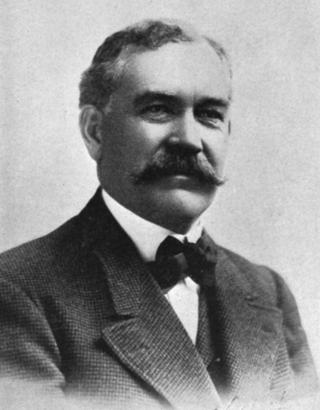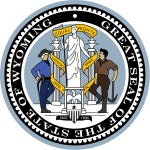
George Washington Thornton Beck was a politician and business entrepreneur in the U.S. state of Wyoming.

The 1900 New York state election was held on November 6, 1900, to elect the governor, the lieutenant governor, the Secretary of State, the state comptroller, the attorney general, the state treasurer and the state engineer, as well as all members of the New York State Assembly and the New York State Senate.

The 1902 South Dakota gubernatorial election was held on November 4, 1902. Incumbent Republican Governor Charles N. Herreid ran for re-election to a second term. He faced former Watertown Mayor John W. Martin, the Fusion nominee who was listed as the Democratic nominee, in the general election. Herreid defeated Martin in a landslide to win his second term.

The 1910 Wyoming gubernatorial election was held on November 8, 1910. Incumbent Republican Governor Bryant B. Brooks declined to seek re-election. The leading Republican candidates to succeed him were initially former U.S. Senator Joseph M. Carey and Attorney General William E. Mullen. However, shortly before the Republican convention, Carey announced he would instead run as an independent candidate. Shortly thereafter, Mullen was formally nominated by the Republican Party. A week later, at the Democratic convention, Carey was named as the Democratic nominee for Governor. In the general election matchup between Carey and Mullen, Carey won a sizable victory, winning every county in the state, a feat that no other Democratic nominee would accomplish until Dave Freudenthal in 2006.

The 1890 Wyoming gubernatorial election was held on September 11, 1890, as the first gubernatorial election for the newly admitted state of Wyoming. Incumbent Territorial Governor Francis E. Warren ran for re-election as the Republican nominee against former Territorial Governor George W. Baxter, the Democratic nominee. Warren defeated Baxter by a decisive margin and became the first popularly elected Governor of Wyoming.

The 1892 Wyoming gubernatorial special election was held on November 6, 1892. Republican Governor Francis E. Warren, who was elected in 1890, resigned several weeks into his term after being elected to the U.S. Senate by the state legislature, elevating Secretary of State Amos W. Barber to the governorship and triggering a special election for the balance of Warren's term.

The 1898 Wyoming gubernatorial election was held on November 8, 1898. Incumbent Republican Governor William A. Richards was a candidate for re-election, but he was defeated for renomination at the Republican convention, which instead nominated DeForest Richards. The Democratic Party joined forces with the Free Silver Republicans to jointly nominate former State Representative Horace C. Alger for Governor. The Populist Party, though reduced in influence from earlier elections, nominated E. B. Viall as its candidate. Though the election was closer than 1894, owing in large part to a dramatic reduction in the share of vote received by the Populist nominee, Roberts defeated Alger by a wide margin.

The 1904 Wyoming gubernatorial election was held on November 8, 1904. Shortly after he began his second term in 1903, Governor DeForest Richards died in office, elevating Secretary of State Fenimore Chatterton to the Governorship and triggering a special election in 1904 to fill the balance of Richards's term. Chatterton ran for re-election, but was defeated for renomination at the Republican convention by Bryant B. Brooks. Former Congressman John E. Osborne, the former Territorial Governor, was nominated by the Democratic Party. Aided by President Theodore Roosevelt's landslide victory over Democrat Alton B. Parker in the presidential election, Brooks overwhelmingly defeated Osborne.

The 1902 Michigan gubernatorial election was held on November 4, 1902. Incumbent Republican Aaron T. Bliss defeated Democratic candidate Lorenzo T. Durand with 52.52% of the vote.

A general election was held in the U.S. state of Wyoming on Tuesday, November 7, 1950. All of the state's executive officers—the governor, secretary of state, auditor, treasurer, and superintendent of public instruction—were up for election. The Republican Party swept all of the offices. Following Democratic governor Lester C. Hunt's election to the U.S. Senate in 1948, Republican secretary of state Arthur G. Crane had been acting as governor. Republican Congressman Frank A. Barrett was elected governor, and Republican candidates won the other statewide races.

A general election was held in the U.S. state of Wyoming on September 11, 1890, to elect the state's executive officers—the governor, secretary of state, auditor, treasurer, and superintendent of public instruction—which were created in the state constitution adopted in 1889. This was the first election in which these offices were for election. The Republican Party performed well, carrying all of them by double-digit margins.

A general election was held in the U.S. state of Wyoming on Tuesday, November 7, 1922. All of the state's executive officers—the Governor, Secretary of State, Auditor, Treasurer, and Superintendent of Public Instruction—were up for election. Democrats improved considerably from their performances in 1918, with William B. Ross winning the gubernatorial election and almost all of their statewide candidates outpacing their 1918 nominees. However, Republicans held all of the other statewide offices.

A general election was held in the U.S. state of Wyoming on Tuesday, November 6, 1894. All of the state's executive officers—the Governor, Secretary of State, Auditor, Treasurer, and Superintendent of Public Instruction—were up for election. The Republican Party, helped by the strong performance of the Populist Party, which operated as a spoiler to the Democratic Party, won back the governorship and improved its margin of victory in all other statewide offices.

A general election was held in the U.S. state of Wyoming on Tuesday, November 8, 1898. All of the state's executive officers—the Governor, Secretary of State, Auditor, Treasurer, and Superintendent of Public Instruction—were up for election. The Republican Party retained all of the offices up for election, though by reduced margins from 1894 as the Populist Party's performance decreased considerably.

A general election was held in the U.S. state of Wyoming on Tuesday, November 4, 1902. All of the state's executive officers—the Governor, Secretary of State, Auditor, Treasurer, and Superintendent of Public Instruction—were up for election. Republicans held onto all statewide offices by landslide margins.

A general election was held in the U.S. state of Wyoming on Tuesday, November 6, 1906. All of the state's executive officers—the Governor, Secretary of State, Auditor, Treasurer, and Superintendent of Public Instruction—were up for election. Republicans held onto all statewide offices by landslide margins.

A general election was held in the U.S. state of Wyoming on Tuesday, November 8, 1910. All of the state's executive officers—the Governor, Secretary of State, Auditor, Treasurer, and Superintendent of Public Instruction—were up for election. Former U.S. Senator Joseph M. Carey won the gubernatorial election, securing the first Democratic win for Governor since 1892. Democratic candidates unseated Republican incumbents in the elections for Secretary of State and Superintendent of Public Instruction, and Republicans narrowly held open seats in elections for State Auditor and Treasurer.

A general election was held in the U.S. state of Wyoming on Tuesday, November 3, 1914. All of the state's executive officers—the Governor, Secretary of State, Auditor, Treasurer, and Superintendent of Public Instruction—were up for election. Governor Joseph M. Carey declined to seek re-election to a second term, and Democratic State Senator John B. Kendrick was elected as his successor. Republicans, however, won all of the other statewide executive offices, including picking up the Superintendent's office.

A general election was held in the U.S. state of Wyoming on Tuesday, November 5, 1918. All of the state's executive officers—the Governor, Secretary of State, Auditor, Treasurer, and Superintendent of Public Instruction—were up for election. Republicans won all statewide offices by wide margins, and with Robert D. Carey's defeat of Frank L. Houx, picked up the governorship following two consecutive losses to Democrats.

The 1900 Washington gubernatorial election was held on November 6, 1900.














